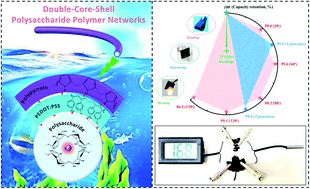Double-core–shell polysaccharide polymer networks for highly flexible, safe, and durable supercapacitors†
Abstract
With the rapid development of portable and wearable electronics, flexible solid-state supercapacitors (FSS-SCs) are urgently needed while still suffer from serious safety risks and the poor electrode–electrolyte interface of regular electrodes. Herein, a biodegradable and flame-retardant electrode with double-core–shell polysaccharide polymer networks (polysaccharide@PEDOT:PSS@polypyrrole, denoted as DCSPP) is developed for integrating high-performance symmetrical FSS-SCs. The superficial swelling and intermolecular interaction ensures sufficient cross-linking of the double-core–shell polymers on the polysaccharide surface, which is beneficial for fast ion mobility and the maximum utilization of all the active materials for charge storage. Along with designing double-core–shell electrodes, the fabricated FSS-SCs exhibit large specific capacitance (57.9 mF cm−2), high energy density (3.94 μW h cm−2), and excellent flexibility (96.8% of the initial capacity after 150° bending). Noteworthily, the FSS-SCs are capable of working even after serious damage, maintaining 99% and 34% of the initial capacity after puncturing and burning, respectively. Benefiting from the double-core–shell networks, compatible electrode–electrolyte interface is promoted for developing safer supercapacitors in various working environments. The superior properties of flexibility, safety, and durability make DCSPP a desirable electrode material for next-generation portable energy storage and wearable smart electronics.



 Please wait while we load your content...
Please wait while we load your content...